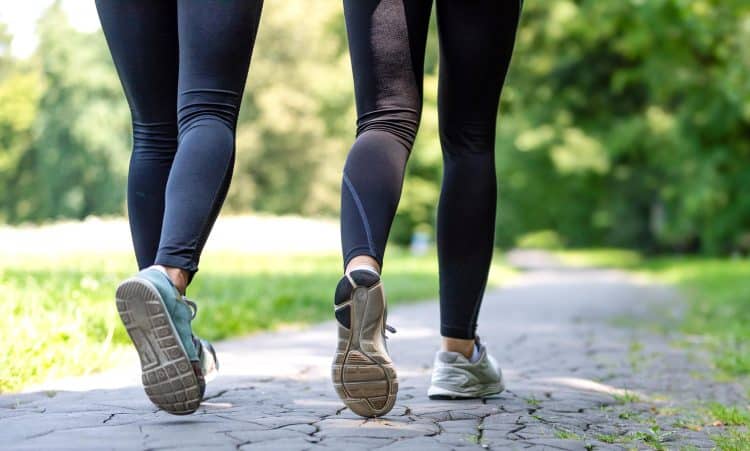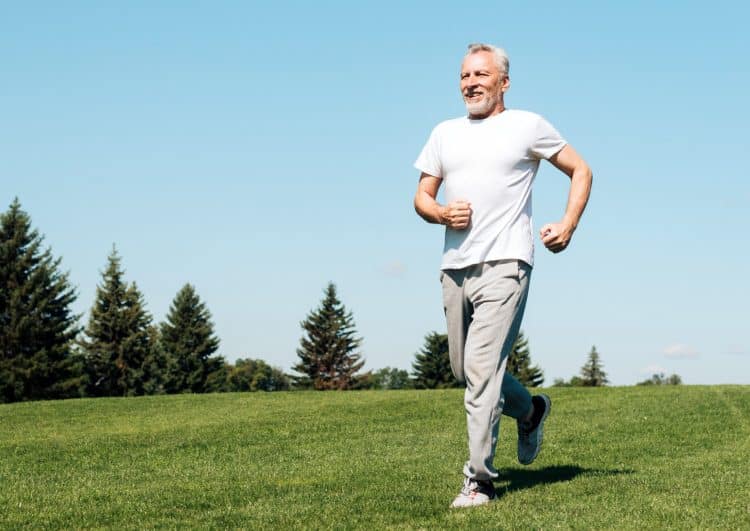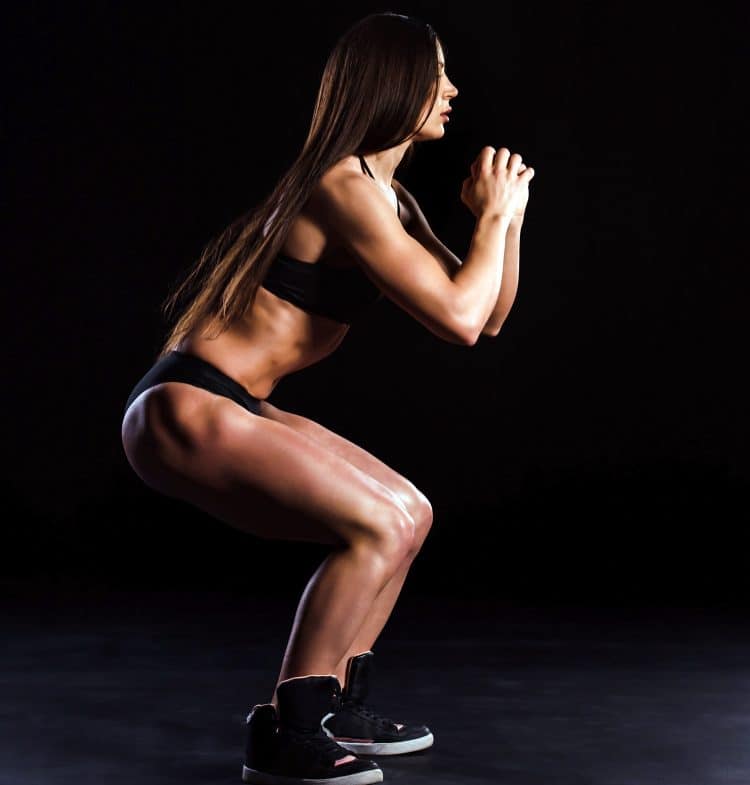Walking is one of the most accessible forms of exercise, suitable for people of all fitness levels.
However, most people underestimate its effectiveness and instead wait for an opportunity to dedicate time to more intensive workouts such as running, swimming, or gym sessions.
Walking 5 miles can help boost overall health and well-being. As a 16-year gym veteran and a personal trainer, I’ve seen firsthand the transformative power of consistent walking, especially over distances like 5 miles.
Walking 5 miles can improve cardiovascular health, fitness, and mental well-being.
The average time to walk 5 miles is approximately 1 hour and 40 minutes, considering a typical walking pace of 20 minutes per mile (3 mph) across varied terrain.
That said, the time it takes to walk this distance can vary significantly based on multiple factors, including age, gender, stride length, fitness level, and terrain.
Level Up Your Fitness: Join our 💪 strong community in Fitness Volt Newsletter. Get daily inspiration, expert-backed workouts, nutrition tips, the latest in strength sports, and the support you need to reach your goals. Subscribe for free!
The difference between walking and running five miles is significant. Running five miles can be exhaustive for newbie fitness enthusiasts, whereas most people can walk the distance comfortably.
Nonetheless, 5 miles (8 kilometers) is considered a long distance and demands consistent training and dedication to build the required cardiovascular base to walk the distance regularly.
In this article, we will explore the significance of walking five miles, including how long it takes to cover the distance, the factors affecting the walking time, health benefits, and how to improve walking speed and aim for bigger goals.
Average Times to Walk 5 Miles (Age and Walking Speed)
The average time to walk 5 miles will vary depending on the gender, age, and walking speed. Before we get into the average time it takes to walk five miles, here is the average walking speed for males and females of different age groups: (1)
| Age | Average Walking Speed for Men (mph) | Average Walking Speed for Women (mph) |
| 20-29 | 3.4 | 3.0 |
| 30-39 | 3.2 | 3.0 |
| 40-49 | 3.2 | 3.11 |
| 50-59 | 3.2 | 2.93 |
| 60-69 | 3.0 | 2.77 |
| 70-79 | 2.82 | 2.53 |
| 80-89 | 2.17 | 2.1 |
The average walking speed for males peaks in the 20 to 29 age bracket (3.4 mph), falls slightly and stagnates in the 30 to 59 age group (3.2 mph) before starting a consistent decline.
On the other hand, the average walking speed for women peaks between the ages of 40 and 49 (3.11 mph), after which it starts to slide gradually.
Now that you know the average walking speed for men and women of different ages, here is the average time it takes them to walk 5 miles:
| Age | How Long Does It Take to Walk 5 Miles — Men | How Long Does It Take to Walk 5 Miles — Women |
| 20-29 | 88.3 minutes (1 hour, 28 minutes, 20 seconds) | 100 minutes (1 hour, 40 minutes) |
| 30-39 | 93.75 minutes (1 hour, 33 minutes, 45 seconds) | 100 minutes (1 hour, 40 minutes) |
| 40-49 | 93.75 minutes (1 hour, 33 minutes, 45 seconds) | 96.4 minutes (1 hour, 36 minutes, 22 seconds) |
| 50-59 | 93.75 minutes (1 hour, 33 minutes, 45 seconds) | 102.5 minutes (1 hour, 40 minutes, 30 seconds) |
| 60-69 | 100 minutes (1 hour, 40 minutes) | 108.3 minutes (1 hour, 38 minutes, 20 seconds) |
| 70-79 | 107.5 minutes (1 hour, 47 minutes, 30 seconds) | 118.6 minutes (1 hour, 58 minutes, 40 seconds) |
| 80-89 | 138.3 minutes (1 hour, 18 minutes, 20 seconds) | 142.5 minutes (2 hours, 22 minutes, 30 seconds) |
Fitness enthusiasts training for a time objective might want to explore how long it takes to walk five miles at different speeds. For this, I have put together this table:
| Walking Speed (mph) | How Long Does It Take to Walk 5 Miles? |
| 2.8 | 1:47:12 |
| 3 | 1:40:00 |
| 3.1 | 1:36:42 |
| 3.2 | 1:33:45 |
| 3.3 | 1:30:51 |
| 3.4 | 1:28:15 |
| 3.5 | 1:25:42 |
| 3.6 | 1:23:22 |
| 3.7 | 1:21:06 |
| 3.8 | 1:18:54 |
| 3.9 | 1:16:45 |
| 4 | 1:15:00 |
| 4.1 | 1:13:12 |
| 4.2 | 1:11:24 |
| 4.3 | 1:09:45 |
| 4.4 | 1:08:12 |
| 4.5 | 1:16:39 |
| 4.6 | 1:05:15 |
| 4.7 | 1:03:45 |
| 4.8 | 1:02:30 |
| 4.9 | 1:01:10 |
| 5 | 1:00:00 |
Knowing the time it takes to complete five miles at different speeds can be incredibly helpful for people who want to squeeze their walking routine into their tight schedules.
Pro Tip: Use a wearable fitness tracker to track your speed, heart rate, and distance covered in real-time. This allows you to adjust the relevant metrics on the fly to achieve your training objective.
Pick a walking speed suitable for your training experience and fitness level. Setting too ambitious a target can lead to frustration and dissatisfaction, which can force you off your fitness regimen without achieving your goals.
Understanding the Distance — 5 Miles
Being a personal trainer has taught me that the chances of people falling off their fitness journey skyrocket if you can’t communicate and contextualize the goals.
Five miles, equivalent to approximately 8 kilometers, is a substantial distance that demands endurance, determination, and commitment.
Five miles on a 400-meter track equates to about 20 laps. This perspective can be useful for people who like to run without a fitness tracker or smartphone to track their distance.
On the other hand, 5 miles in an urban setting is roughly equal to walking across 100 city blocks.
I hope this breakdown will help you make sense of the 5-mile benchmark and allow you to gauge your ability to undertake this distance better, prepare mentally and physically for this challenge, and measure your progress.
Also Read: 5,000 Steps to Miles (A Simple Conversion To Lose Weight)
Factors Influencing the Time It Takes To Walk 5 Miles
Here are the factors that can influence walking time:
Age
As you’ve probably seen from the table above, age can significantly impact an individual’s walking pace.
Younger individuals (in their 20s and 30s) have greater stamina and muscular strength, allowing them to maintain a faster pace (3 to 4 mph) and cover a more significant distance in a shorter time.
On the other hand, seniors, especially those over 60, find a slower pace (2.3 to 3 miles) per hour more comfortable.
Body changes that are normal with age, like reduced muscle mass and joint flexibility, can lead to slower walking speeds.
Level Up Your Fitness: Join our 💪 strong community in Fitness Volt Newsletter. Get daily inspiration, expert-backed workouts, nutrition tips, the latest in strength sports, and the support you need to reach your goals. Subscribe for free!
A systematic review and meta-analysis published in the Journal of Physiotherapy involving data from 51,248 adults found that male gait speed tends to slow down after the age of 50 years. In contrast, for females, this slowing becomes noticeable after 30 years. (2)
Sex
Men usually walk faster than ladies because of the differences in muscle mass and limb length. However, this difference can vary for each individual and is often overshadowed by individual fitness levels.
Fitness Level
In a continuation of the previous point, a person’s fitness level significantly impacts their walking pace. This difference is even more prominent on challenging terrains.
A study published in the Journal of Biomechanics found that BMI (body mass index), in addition to age and sex, is crucial in understanding the mechanics of walking. These could help tailor walking programs or rehabilitation strategies based on individual demographics. (3)
Walking Pace
And finally, an individual’s natural walking pace dictates how long it takes to walk 5 miles. An individual’s walking pace is determined by their fitness level, biomechanics, and even their day-to-day energy levels.
How To Improve Walking Speed
As walking 5 miles can take around 1 hour and 40 minutes at a 3 mph (20 minutes per mile) speed, it might not be viable for people with busy schedules.
Improving walking speed can help cover the distance in less time, making the objective more suitable for busier folks.
Here are some tried and true tips to improve walking speed:
Improve Your Walking Form
The walking form is one of the most overlooked aspects. While trying to improve walking pace, most people never evaluate their walking form, leaving significant gains on the table.
Working with a running coach can help improve your form, which can result in faster mile times. It can also help you take on more elaborate challenges while reducing injury risk. Hiring a professional can save you a considerable amount of money, time, and effort in the long term.
Increase Your Stride Turnover
Contrary to what most people think, the key to walking faster consistently is not taking longer strides but increasing the number of steps you take. Increasing your stride length can put undue stress on your hamstrings, increasing the risk of tears and strains.
I recommend my clients begin counting their steps per minute to improve their walking speed. Once you have the number, work on increasing your steps per minute gradually. A 5 percent increase per week is an achievable and realistic target.
Next Read: Walking 2 Miles a Day (And Why It’s Easier Than You Think)
Strengthen Your Core and Lower Body
Incorporating lower-body workouts, including quads, hamstrings, and calves, into your training regimen can improve your lower-body strength and boost your walking speed. Squats, lunges, and leg presses are some of the most effective exercises to build leg strength.
Perform Interval Training
High-intensity interval training (HIIT) is one of the most effective ways to build strength, speed, agility, cardiovascular fitness, stamina, and endurance, all of which can help improve your walking pace.
Beginners can start by performing HIIT workouts once each week. Walking HIIT workouts will include mixing periods of fast walking with intervals of slower walking to build speed and endurance. Increase the frequency as you get more proficient.
Improve Your Endurance
Walking at 3 to 4 mph for 5 miles (8 kilometers) requires decent stamina and endurance. Gradually increase your walking distance or duration each week to effectively maintain a quick pace for longer distances.
Wear Proper Footwear
Walking in the right footwear can make a night-and-day difference. Wear walking shoes that provide good support and are suitable for your feet. Avoid walking in flip-flops or sandals, and wear shoes that offer a good balance of comfort and support.
Walking Speeds and Health Benefits
The correlation between walking speeds, calories burned, and the resultant benefits is not only significant but also multi-dimensional.
Your walking pace determines your workout intensity, which plays a crucial role in how many calories you burn. An average person usually walks at a speed of 3 to 4 miles per hour. Walking at this pace will take approximately 1.25 to 1.67 hours. Notably, this duration can change depending on factors like age, fitness level, terrain, and gender.
Brisk walking elevates your heart rate, leading to increased metabolic activity. A higher metabolic rate helps you burn calories throughout the day, even when you are not physically active.
Walking is as beneficial for mental health as it is for physical. Walking at a moderate to brisk pace releases endorphins, the body’s natural mood elevators. Endorphins can help lower stress and anxiety levels, lowering the risk of depression.
Finally, walking strengthens muscles, improves bone density, and boosts balance and coordination. This low-impact exercise is suitable for people of all experience levels. Walking is also a suitable exercise for people dealing with injuries.
That said, people dealing with health issues should get their doctor’s clearance before starting any new exercise regimen.
Check Out: How Many Calories Should I Burn a Day?
Conclusion
An average adult can walk 5 miles in about 1:40 hours at a speed of 3 mph (20 minutes per mile). However, the exact time it takes you to walk this distance can vary depending on factors like age, gender, stride length, speed, and fitness level.
If you have any questions about the time it takes to walk 5 miles, drop them in the comments below, and I’ll be happy to help!
References
- Schimpl M, Moore C, Lederer C, Neuhaus A, Sambrook J, Danesh J, Ouwehand W, Daumer M. Association between walking speed and age in healthy, free-living individuals using mobile accelerometry–a cross-sectional study. PLoS One. 2011;6(8):e23299. doi: 10.1371/journal.pone.0023299. Epub 2011 Aug 10. PMID: 21853107; PMCID: PMC3154324.
- Andrews AW, Vallabhajosula S, Boise S, Bohannon RW. Normal gait speed varies by age and sex but not by geographical region: a systematic review. J Physiother. 2023 Jan;69(1):47-52. doi: 10.1016/j.jphys.2022.11.005. Epub 2022 Dec 16. PMID: 36528509.
- Chehab EF, Andriacchi TP, Favre J. Speed, age, sex, and body mass index provide a rigorous basis for comparing the kinematic and kinetic profiles of the lower extremity during walking. J Biomech. 2017 Jun 14;58:11-20. doi: 10.1016/j.jbiomech.2017.04.014. Epub 2017 Apr 20. PMID: 28501342.












Very helpful and loaded with lots of information about the way to your understanding the whole concept is walking